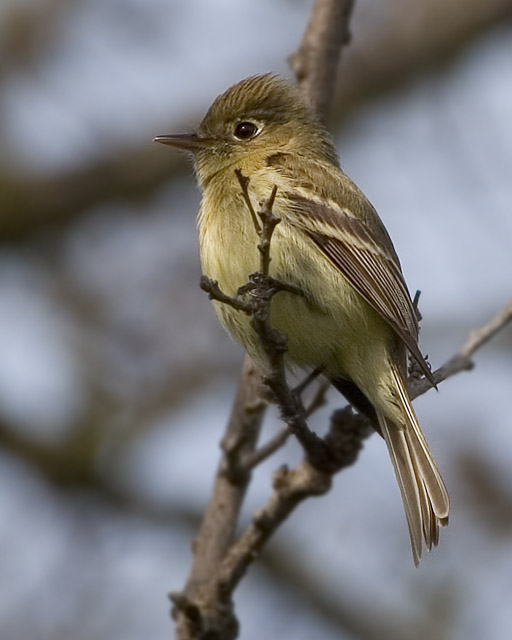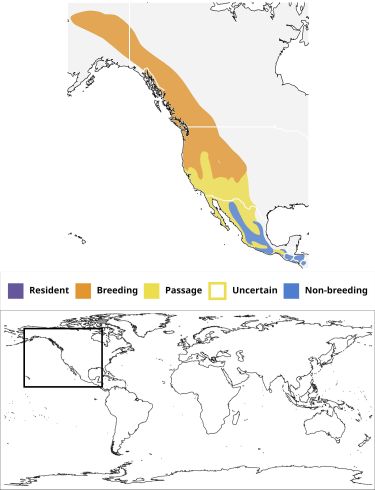JohnN-1520 (talk | contribs) |
m (→Taxonomy) |
||
| (15 intermediate revisions by 7 users not shown) | |||
| Line 1: | Line 1: | ||
| − | + | [[Image:Hammonds_Flycatcher.jpg|thumb|550px|right|Photo by {{user|corvidophile|corvidophile}}<br />[[Malibu Creek State Park]], [[California]], March 2005]] | |
| − | [[Image:Hammonds_Flycatcher.jpg|thumb|550px|right|Photo by corvidophile <br/> | + | ;[[:Category:Empidonax|Empidonax]] hammondii |
==Identification== | ==Identification== | ||
| + | 12.5-14.4 cm, 7.7-12.1 g<br /> | ||
| + | *Olive-gray upperparts | ||
| + | *Light throat | ||
| + | *Gray breast | ||
| + | *Pale yellow wash on belly | ||
| + | *White eye ring | ||
| + | *Very long primary projection | ||
| + | *White wing bars | ||
| + | *Juvenile slightly more obvious yellow wash on belly than adult | ||
| + | ====Similar Species==== | ||
| + | Throat not as white as [[Alder Flycatcher]]; wing longer, breast darker and bill narrower and shorter than [[Dusky Flycatcher]]. | ||
| + | Likely to overlap with [[Acadian Flycatcher]], [[Alder Flycatcher]], [[Buff-breasted Flycatcher]], [[Cordilleran Flycatcher]], [[Dusky Flycatcher]], [[Gray Flycatcher]], [[Least Flycatcher]], [[Pacific-slope Flycatcher]], [[Pine Flycatcher]], [[White-throated Flycatcher]], [[Willow Flycatcher]], [[Yellow-bellied Flycatcher]], [[Yellowish Flycatcher]]. | ||
| − | + | See also [[Empidonax|<i>Empidonax</i>]]. | |
==Distribution== | ==Distribution== | ||
| − | Breeds from eastern [[Alaska]] south to northern California and northern New Mexico. Winters | + | Breeds from eastern [[Alaska]] south to northern [[California]] and northern [[New Mexico]]. |
| + | |||
| + | Winters from [[Mexico]] south to [[Nicaragua]], rarely in southern [[Arizona]]. | ||
| + | |||
| + | Accidental vagrant to northeast ([[New York]], [[Pennsylvania]], and [[Rhode Island]]), midwest ([[Michigan]]) and the Gulf Coast ([[Alabama]], [[Louisiana]], and [[Texas]]). | ||
| + | |||
| + | [[File:20230517_Empidonax_hammondii.jpg|375px|thumb|right|Approximate distribution map. From Xeno canto / NatureServe data at file date (from Xeno Canto)]] | ||
==Taxonomy== | ==Taxonomy== | ||
| − | + | ====Subspecies==== | |
| + | Cements regards this as a [[Dictionary_M-O#M|monotypic]] species [[#References|[1]]]. | ||
==Habitat== | ==Habitat== | ||
| − | + | Coniferous and mixed forests. Riparian areas of tall trees, where usually perches high in conifers<sup>[[#References|[2]]]</sup>. Also brush in arid country on migration. | |
| − | |||
==Behaviour== | ==Behaviour== | ||
| − | 3 or 4 white eggs, occasionally spotted, in a well-built cup nest | + | Inclined to flick wings and tail rather more than other similar species. |
| + | ====Breeding==== | ||
| + | The clutch consists of 3 or 4 white eggs, occasionally spotted, in a well-built cup nest placed on a branch high in a tree. | ||
| + | ====Vocalisation==== | ||
| + | '''Song''': ''seweep-tsurp-seep'', the last part rising<br /> | ||
| + | '''Calls''': a high ''peep'' (similar to a [[Pygmy Nuthatch]]) and a soft ''wit''. | ||
| + | ==References== | ||
| + | #{{Ref-Clements6thAug16}}#Sibley Bird Guide | ||
| + | #BF Member observations | ||
| + | {{ref}} | ||
==External Links== | ==External Links== | ||
{{GSearch|Empidonax+hammondii}} | {{GSearch|Empidonax+hammondii}} | ||
| − | [[Category:Birds]] | + | [[Category:Birds]] [[Category:Empidonax]][[Category:Maps]] |
Latest revision as of 15:59, 12 October 2023
- Empidonax hammondii
Identification
12.5-14.4 cm, 7.7-12.1 g
- Olive-gray upperparts
- Light throat
- Gray breast
- Pale yellow wash on belly
- White eye ring
- Very long primary projection
- White wing bars
- Juvenile slightly more obvious yellow wash on belly than adult
Similar Species
Throat not as white as Alder Flycatcher; wing longer, breast darker and bill narrower and shorter than Dusky Flycatcher.
Likely to overlap with Acadian Flycatcher, Alder Flycatcher, Buff-breasted Flycatcher, Cordilleran Flycatcher, Dusky Flycatcher, Gray Flycatcher, Least Flycatcher, Pacific-slope Flycatcher, Pine Flycatcher, White-throated Flycatcher, Willow Flycatcher, Yellow-bellied Flycatcher, Yellowish Flycatcher.
See also Empidonax.
Distribution
Breeds from eastern Alaska south to northern California and northern New Mexico.
Winters from Mexico south to Nicaragua, rarely in southern Arizona.
Accidental vagrant to northeast (New York, Pennsylvania, and Rhode Island), midwest (Michigan) and the Gulf Coast (Alabama, Louisiana, and Texas).
Taxonomy
Subspecies
Cements regards this as a monotypic species [1].
Habitat
Coniferous and mixed forests. Riparian areas of tall trees, where usually perches high in conifers[2]. Also brush in arid country on migration.
Behaviour
Inclined to flick wings and tail rather more than other similar species.
Breeding
The clutch consists of 3 or 4 white eggs, occasionally spotted, in a well-built cup nest placed on a branch high in a tree.
Vocalisation
Song: seweep-tsurp-seep, the last part rising
Calls: a high peep (similar to a Pygmy Nuthatch) and a soft wit.
References
- Clements, J. F., T. S. Schulenberg, M. J. Iliff, D. Roberson, T. A. Fredericks, B. L. Sullivan, and C. L. Wood. 2016. The eBird/Clements checklist of birds of the world: v2016, with updates to August 2016. Downloaded from http://www.birds.cornell.edu/clementschecklist/download/
- Sibley Bird Guide
- BF Member observations
Recommended Citation
- BirdForum Opus contributors. (2024) Hammond's Flycatcher. In: BirdForum, the forum for wild birds and birding. Retrieved 2 May 2024 from https://www.birdforum.net/opus/Hammond%27s_Flycatcher





